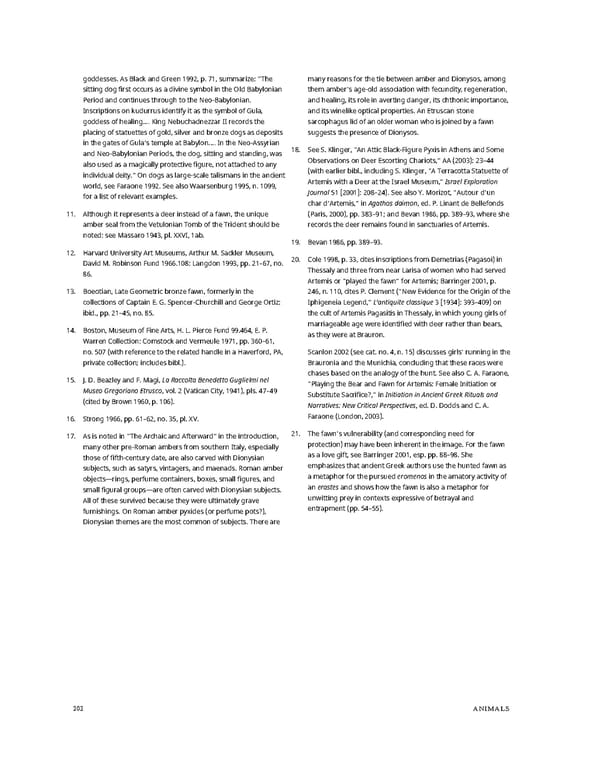goddesses. As Black and Green 1992, p. 71, summarize: “The many reasons for the tie between amber and Dionysos, among sitting dog first occurs as a divine symbol in the Old Babylonian them amber’s age-old association with fecundity, regeneration, Period and continues through to the Neo-Babylonian. and healing, its role in averting danger, its chthonic importance, Inscriptions on kudurrus identify it as the symbol of Gula, and its winelike optical properties. An Etruscan stone goddess of healing.… King Nebuchadnezzar II records the sarcophagus lid of an older woman who is joined by a fawn placing of statuettes of gold, silver and bronze dogs as deposits suggests the presence of Dionysos. in the gates of Gula’s temple at Babylon.… In the Neo-Assyrian 18. See S. Klinger, “An Attic Black-Figure Pyxis in Athens and Some and Neo-Babylonian Periods, the dog, sitting and standing, was Observations on Deer Escorting Chariots,” AA (2003): 23–44 also used as a magically protective figure, not attached to any (with earlier bibl., including S. Klinger, “A Terracotta Statuette of individual deity.” On dogs as large-scale talismans in the ancient Artemis with a Deer at the Israel Museum,” Israel Exploration world, see Faraone 1992. See also Waarsenburg 1995, n. 1099, Journal 51 [2001]: 208–24). See also Y. Morizot, “Autour d’un for a list of relevant examples. char d’Artemis,” in Agathos daimon, ed. P. Linant de Bellefonds 11. Although it represents a deer instead of a fawn, the unique (Paris, 2000), pp. 383–91; and Bevan 1986, pp. 389–93, where she amber seal from the Vetulonian Tomb of the Trident should be records the deer remains found in sanctuaries of Artemis. noted: see Massaro 1943, pl. XXVI, 1ab. 19. Bevan 1986, pp. 389–93. 12. Harvard University Art Museums, Arthur M. Sackler Museum, 20. Cole 1998, p. 33, cites inscriptions from Demetrias (Pagasoi) in David M. Robinson Fund 1966.108: Langdon 1993, pp. 21–67, no. Thessaly and three from near Larisa of women who had served 86. Artemis or “played the fawn” for Artemis; Barringer 2001, p. 13. Boeotian, Late Geometric bronze fawn, formerly in the 246, n. 110, cites P. Clement (“New Evidence for the Origin of the collections of Captain E. G. Spencer-Churchill and George Ortiz: Iphigeneia Legend,” L’antiquite classique 3 [1934]: 393–409) on ibid., pp. 21–45, no. 85. the cult of Artemis Pagasitis in Thessaly, in which young girls of 14. Boston, Museum of Fine Arts, H. L. Pierce Fund 99.464, E. P. marriageable age were identified with deer rather than bears, Warren Collection: Comstock and Vermeule 1971, pp. 360–61, as they were at Brauron. no. 507 (with reference to the related handle in a Haverford, PA, Scanlon 2002 (see cat. no. 4, n. 15) discusses girls’ running in the private collection; includes bibl.). Brauronia and the Munichia, concluding that these races were 15. J. D. Beazley and F. Magi, La Raccolta Benedetto Guglielmi nel chases based on the analogy of the hunt. See also C. A. Faraone, Museo Gregoriano Etrusco, vol. 2 (Vatican City, 1941), pls. 47–49 “Playing the Bear and Fawn for Artemis: Female Initiation or (cited by Brown 1960, p. 106). Substitute Sacrifice?,” in Initiation in Ancient Greek Rituals and Narratives: New Critical Perspectives, ed. D. Dodds and C. A. 16. Strong 1966, pp. 61–62, no. 35, pl. XV. Faraone (London, 2003). 17. As is noted in “The Archaic and Afterward” in the introduction, 21. The fawn’s vulnerability (and corresponding need for many other pre-Roman ambers from southern Italy, especially protection) may have been inherent in the image. For the fawn those of fifth-century date, are also carved with Dionysian as a love gift, see Barringer 2001, esp. pp. 88–98. She subjects, such as satyrs, vintagers, and maenads. Roman amber emphasizes that ancient Greek authors use the hunted fawn as objects—rings, perfume containers, boxes, small figures, and a metaphor for the pursued eromenos in the amatory activity of small figural groups—are often carved with Dionysian subjects. anerastes and shows how the fawn is also a metaphor for All of these survived because they were ultimately grave unwitting prey in contexts expressive of betrayal and furnishings. On Roman amber pyxides (or perfume pots?), entrapment (pp. 54–55). Dionysian themes are the most common of subjects. There are 202 ANIMALS
 Ancient Carved Ambers in the J. Paul Getty Museum Page 211 Page 213
Ancient Carved Ambers in the J. Paul Getty Museum Page 211 Page 213